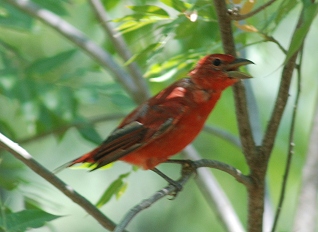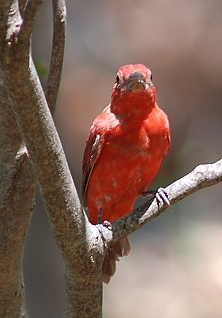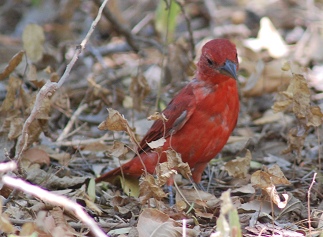Some of the birds on the place usually stay away from the house, but in this severe drought we have the only substantial water (the creek’s dry at the south end of town, a mile downstream–and probably beyond that, too.) In the past week, with a slightly decreased workload, I’ve been out looking for migrants in the back yard–hearing more different songs. Today I was lucky enough to photograph this gorgeous male summer tanager:

He looks a bit rough because he had taken a bath and was grooming himself. I think he may also be molting, but I don’t know when tanagers molt. It was amazing to have the yellow warbler and the tanager in view at the same time (they did not, of course, pose together!) Yellow warblers sometimes come into the house yard during migration, but usually I find them out near Owl Pavilion or at the creek, if there’s water in it. Also in the area (and not photographed) was a white-eyed vireo–these nest in the creek woods and the dry woods, but don’t usually come up to the house. Earlier, I’d seen a juvenile painted bunting, which I photographed, but the adult female stayed behind leaves. This is the first year we’ve seen painted buntings up near the house.
I think the female tanager was also around, but too shy to come for a picture; the male, much bolder, hopped around in the bushes and trees and even on the ground while I photographed him.


Comment by gunhilda — August 26, 2009 @ 3:42 pm
Beautiful! I wish you’d gotten a photo of the white-eyed vireo, too. 🙂
Comment by elizabeth — August 26, 2009 @ 3:48 pm
I’ve gotten those before, but not in the back yard…my best shot so far is one in early September 2006, down in the creek woods–it’s the fourth image on that page. The bird today was very skittish and keeping leaves between us. However, it may be bolder another day. I’ll keep trying.
Comment by Claire Eamer — August 26, 2009 @ 9:33 pm
Here in the Yukon, we’re at the other end of the migration. The swallows have left, and most of the gulls and Arctic terns have gone. The pine siskins are still hanging around our backyard feeder, pigging out on seeds, but only a few of the red crossbills are left. We saw a little flock of yellow-rumped warblers snacking on fireweed yesterday. Do any of our guys (or their relatives) show up in your neighbourhood?
Comment by elizabeth — August 27, 2009 @ 9:00 am
We do get yellow-rumped warblers as winter residents. The pine siskins usually show up late winter/early spring as semi-migrants (some places near here have them most of the winter.) We have no swallows in winter (our swallows head south too) and others usually over-fly us in migration. We’re on the Central Flyway–we pick up a lot of songbirds (I’ve seen 19 species of warblers altogether, plus buntings, grosbeaks, robins, orioles, bluebirds, every kind of blackbird just about), a few hawks, and the water birds overfly us to head for lakes (that’s going to be tough this year) and the coast. But we see flocks of ducks, geese, and of course sandhill and whopping cranes overhead.
Our winter visitor population (the winter-residents) includes up to 12 species of more northern sparrows, yellow-rumped and orange-crowned warblers, ruby-crowned kinglets, northern flicker, cedar waxwings, American pipit, winter and house wrens, brown thrasher, American goldfinch, and western year-round or winter-residents that arrive on certain kinds of winter storm fronts. That can include prairie falcon and pyrrhuloxia.
The total for this place (which is probably not the true total, since I’m not out there every day in migration seasons) is 154 species. Dedicated birders in this area have many more on their list…the best reference for the counties in my area lists 349 species found “with some regularity” but another 74 are “accidentals.”
Comment by elizabeth — August 29, 2009 @ 9:44 am
Yesterday, Friday, I finally saw the female summer tanager clear enough to be sure of the ID, but was unable to get a photograph.